The story of PRS Guitars is a wild ride that could be framed around Paul Reed Smith’s taste for perfectionism in electric guitar design meeting his appetite for risk, the influence of Ted McCarty on his tastes in guitars, and the audacity to present maple-topped guitars to a market that had long since been seduced by solid painted finishes.
But really it can be framed around the two 1984 sample guitars he took on the road to get the company up and running, and in the latest episode of PRS’s From The Archives YouTube series, Smith does just that as he is joined by the brand’s art director, Marc Quigley, for a history lesson that shines a light not just on PRS the brand but how the guitar market has changed since the mid ‘80s.
The guitars in question are a PRS Custom No Serial Number and a PRS guitar. The Custom would soon evolve into the Custom 24 we know today. The PRS would become the Standard in 1987. Both would be pillars of the lineup, with the Custom 24 being many player's idea of the acme of high-end electric guitar making.
Back in 1984, though, nobody knew who they were, and having made a gentleman’s agreement with an Indianapolis lawyer who said he’d front the capital to start the business if Smith returned with $100,000 of orders, Smith hit up the East Coast with two guitars and a sales pitch.
He came back with orders worth $300,000 and the lawyer backed out. Warren Esanu, PRS’s chairman to this day, stepped in. The company was formed in 1985. But Smith says securing the orders, getting the finance, paying the rent on the facility was not when he knew things were going to be okay. It was when the retailers phoned up and wanted more.
“What felt really good was the day that the dealers paid for the guitars and they sold them and then I got a reorder,” says Smith. “That was the relieving moment. The relieving moment was the reorder. I’ve seen products go out the door, dealers sold them just like that, didn’t want another one.”

Smith talks about his relationship with his mentor, Ted McCarty, who explained why Gibson had used maple for the tops in the first place. This is where it gets interesting. Because at this point in time, PRS was swimming against the tide. Nobody was making guitars with maple tops in the ‘80s and no one was playing them.
“People were painting guitars,” he says. “They were black and white, and graphics and this, that and the other, but it was time for the curly maple to return to our industry. As far as I’m concerned, curly maple is part of the legacy of guitars – especially from Gibson in the ‘50s, starting in 1959, big time again, ’58. So I always thought it was cool.
There was no curly maple guitars. Steinberger guitars were hot. Jackson guitars were hot. Kramer guitars were hot
“But at the time the only curly maple guitars at NAMN, our trade shows, were in violin booths. On the back of a violin; they weren’t even on the front. There was no curly maple guitars. Steinberger guitars were hot. Jackson guitars were hot. Kramer guitars were hot.”
Ted McCarty explained the Gibson strategy. Maple on top of mahogany was the sound they were after, and in a two-horse race against Leo Fender, they new there wasn’t a carving machine at Fullerton, CA. And of course Gibson would initially hide this design feature under gold paint before making it a selling point in 1958.
Could a similar selling point work in the ‘80s – a decade of hair metal, hot-pink Soloists, Spandex?

A visit to Richard Ash of Sam Ash Music on 48th Street, New York, suggested yes. He placed a big order, and repeated it, and half of them were Customs. “This was a return to the days of the ‘50s,” says Smith.
Looking at the ’84 sample Custom now, Smith catalogues the many reasons why it would not pass QC today, and walks through the design features that changed.
It was the same for the all-mahogany PRS guitar, which would become the Standard in 1987. This prototype had moon inlays. Ultimately the bird inlays, which were hand-cut on a jeweller’s saw in the early days, won out – much to Smith’s surprise. He thought the moon inlays would be the seller.
The PRS guitar sample performed a more radical role in selling the brand. It went on tour with Ted Nugent. “I needed every bit of advertising I could possibly get,” says Smith.
We’ll let Smith pick up the story from there in the video above, and explain why his name’s on the headstock, how the 10-Top model came to be, and a lot more besides.







